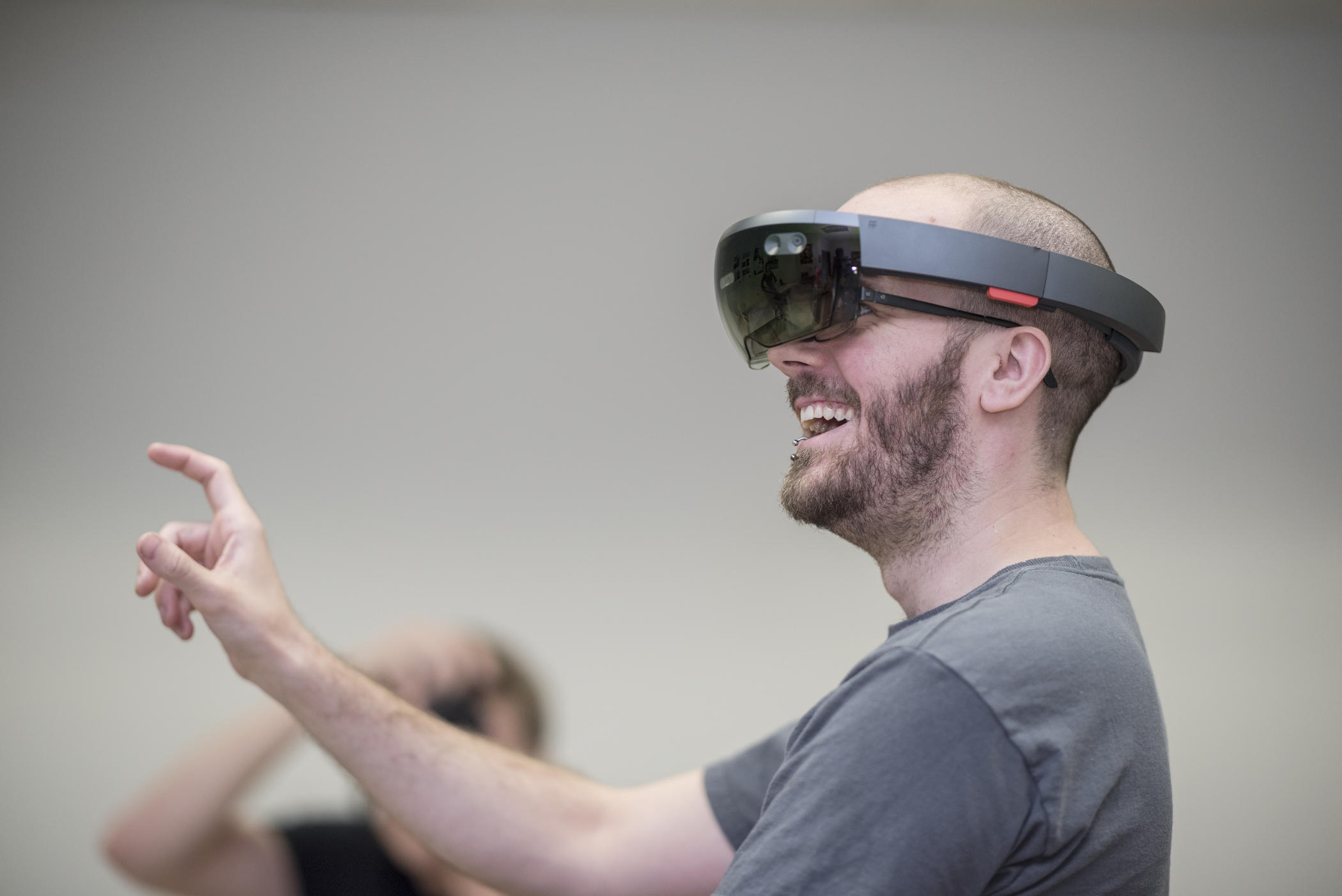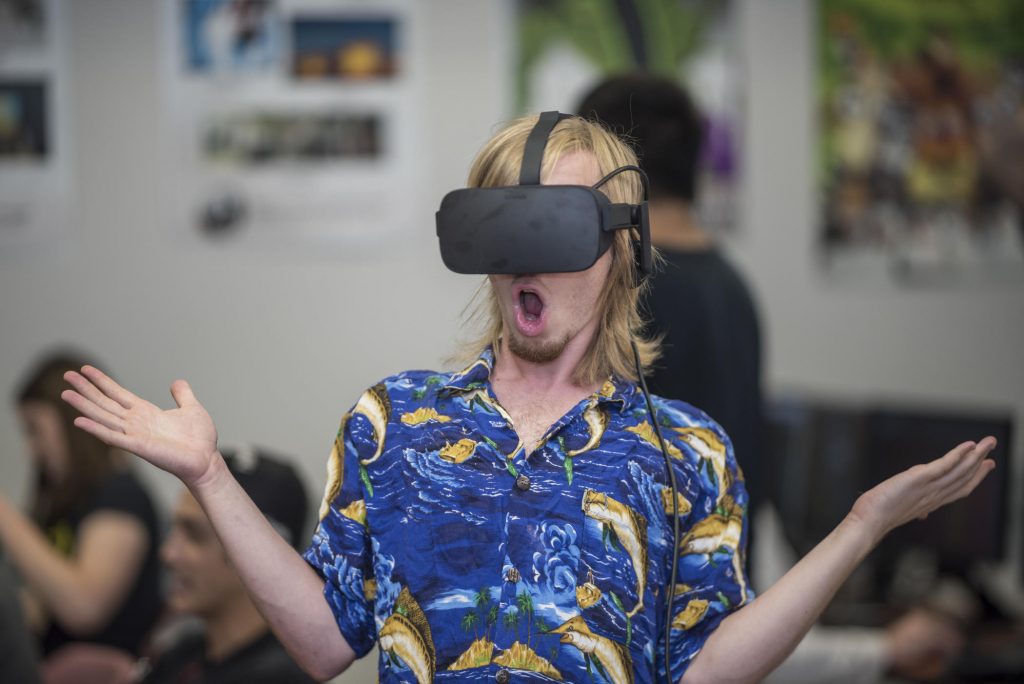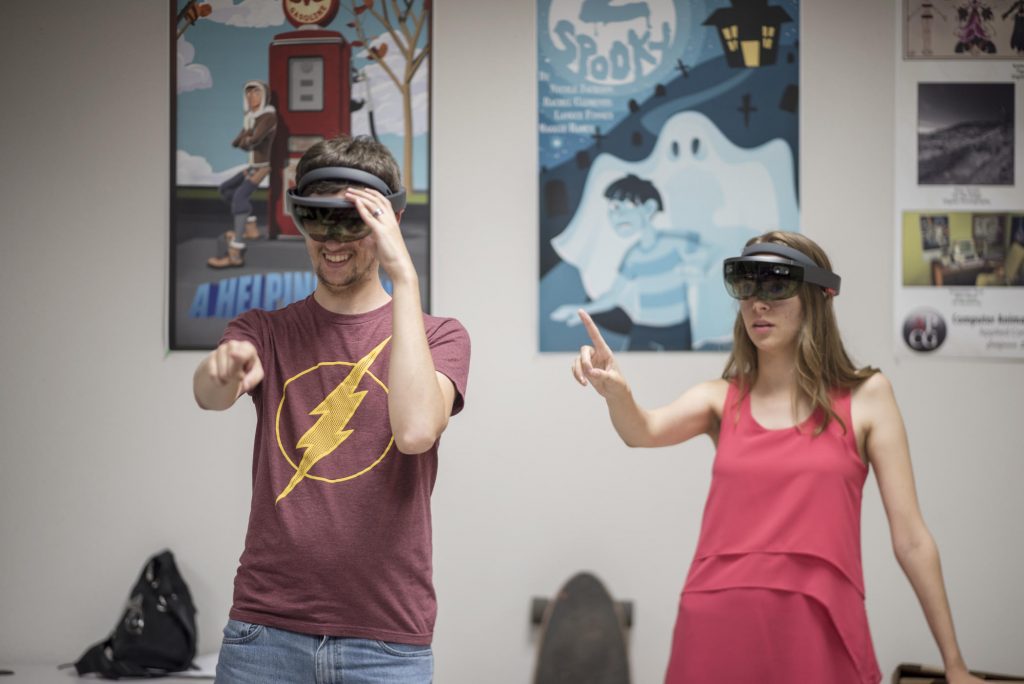Vision Becomes (Virtual) Reality: Collaborative VR Course Presents Opportunities

Computer Animation and Game Development (CAGD) student Lance Mitchell wears a Microsoft HoloLens.
Signs kept appearing. They screamed, “The future is here, and it’s technology!”
For the better part of a year, Computer Animation and Game Development (CAGD) Program Director Clarke Steinback had approached Journalism and Public Relations Department Chair Susan Wiesinger about a possible collaborative class, pointing out similarities between their operations, especially in how the disciplines simulate their respective field’s industry as part of the coursework.
The alliance, a seemingly natural if not obvious fit, took time to come to fruition. At the beginning of the year, Journalism and PR began putting together a special topics course for the fall, but didn’t see where CAGD would fit into its plans.
But then, while planning a trip to connect with Seattle alumni, Wiesinger picked up on a glaring common thread: Every one of the 24 Wildcats who converged were tech professionals.
Wiesinger knew then that Steinback was truly on to something. The collaboration was on.

This fall, one of the fastest-growing industries in America became the center of an innovative interdisciplinary pilot course at Chico State. Virtual and augmented reality—projected by Business Insider to be a $162-billion market by 2020—is the focus of a three-program, two-college partnership class, “Virtual & Augmented Reality for Media & Gaming.” Journalism and PR, CAGD, and the department of Media Arts, Design, and Technology (MADT) have teamed up to teach 30 students this cutting-edge medium.
The coursework combines a multitude of skills—from content development and design to social media messaging and public relations communications. Student course fees and a generous, anonymous alumni gift went toward funding state-of-the-art VR headsets for each student, and with a 360-degree camera, Microsoft HoloLens, Oculus Rift and HTC Vives on hand, students have been mapping and viewing Chico landmarks and events to simulate virtual tours, among other hands-on projects.
“It’s pretty cool, with all the different tech we’ve gotten to learn about. It’s a really different way to tell our stories,” said senior Jafete Serrato, a journalism major from Orland. “What drew me in is that it’s not this traditional kind of class—there’s a lot of useful technology that we’re learning how to use that nobody else is learning. I think that will make me more attractive to potential employers in the future.”
But the technology isn’t all that makes the collaborative course special. Legal and ethical issues like copyright and privacy law—linchpins of responsible journalism and PR—are covered for everyone involved. Where journalism students are delving into the industry’s tech aspect in this course, developers and designers also learn to get a feel for the media side of things. Industry trend-tracking, content promotion and distribution, and user experience considerations are all part of the course, with the emphasis on narrative first and foremost.
“I think that’s my favorite part about it, is that we’re learning how to incorporate VR into real-life journalism,” Serrato said. “It’s unique—it sets us apart from other schools, and it definitely gives you a whole new experience.”

At its core, CAGD/JOUR/MADT 398 is a storytelling class. But the exciting possibilities the tools of VR offer mean that those stories have potential they’ve never had before.
“There is not a discipline on this campus that hasn’t been changed in some way by tech,” Wiesinger said. “This collaboration helps make journalism sexy. It wouldn’t foundationally change our values—ethics, professionalism, free speech and content production are always going to underpin what we do—but what we’re seeing right now is students working together in teams that look like they do in industry.”
CAGD already models itself after an industry setting, too, but having the programs mingle is a collaborative step for students that wasn’t there before. Seeing how they’ve responded has been gratifying thus far for the course’s instruction team of Steinback, Wiesinger, MADT chair Jennifer Meadows, and CAGD’s Jeff Underwood.
“Our curriculum and our program is based on a team dynamic, so you have to step outside of your own kind, so to speak, sometimes” Steinback said. “You have to talk, you have to communicate, and you have to understand scope and scale. You have to work on something that’s not yours. They prepare to work in the industry that way, because that’s how content is generated in this millennium.
“In a lot of ways, people still don’t get that, so it’s exciting to know we have the vision and our students are doing it, right now.”
While it’s deemed a pilot course, Wiesinger smilingly refers to it as a “prove-it” course—prove a full curriculum can work between three programs and two colleges, and it will stand as a proof of concept for a larger goal: a dedicated school of media, entertainment and technology (MET).
Media arts is a highly sought-after discipline in colleges across the country, with Syracuse University’s journalism school already shifting into a similarly grouped unit involving art, technology, and gaming. Oregon State’s counterpart program already is nearing 500 majors after starting it from scratch in 2012, according to Oregon State School of Arts and Communication Director Lee Ann Garrison.
The interest is intense, and that’s why Wiesinger, Steinback, and Meadows said they’d love to see an integrated school that focuses on industry preparation for the growing field of entertainment and tech media.
“There is a very good synergy between the three of us, and it makes us realize how well an MET (program or school) would work,” Steinback said. “We can create a scenario where Chico is an industry-known program. The students are fascinated and interested, and this content generation system works.”
The curriculum is bolstered by faculty and alumni guest speakers providing even more industry insight. Michael Beadle (BA, Journalism, ’96), now senior manager of public relations for gaming giant Ubisoft, is scheduled to speak to students about its VR efforts the first week of November, right when the course begins its foray into applied VR and AR in media and entertainment.
So far, faculty and students alike have shown a fondness for the new course, not just for its curriculum, but also for the efforts that created it. Perhaps most promising, at least when it comes to the exciting prospects of an MET program, is that the shared vision between departments has come to fruition so quickly thanks to the buzz surrounding VR and AR. In just two months, Wiesinger said, the course has generated enough interest for a second semester, and the group has a verbal agreement with Sierra Nevada to partner on a virtual reality-centric project in the spring.
“Putting this class together was a way of showing everyone, ‘Hey, look what we can do together—we can create something really amazing,” Meadows said. “I love this class. Our departments are working well together and the students are, too. I really leave it very energized, every time.”


